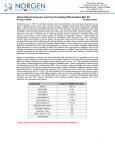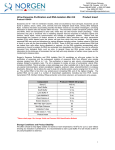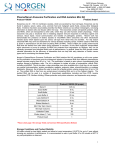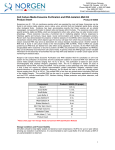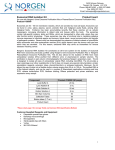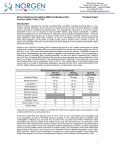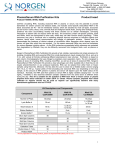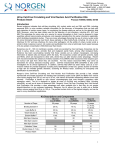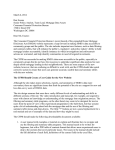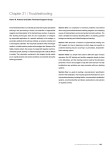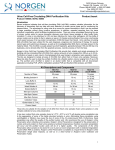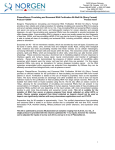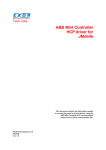Download Plasma/Serum Exosome and Free-Circulating RNA Isolation Midi Kit
Transcript
3430 Schmon Parkway Thorold, ON, Canada L2V 4Y6 Phone: 866-667-4362 (905) 227-8848 Fax: (905) 227-1061 Email: [email protected] Plasma/Serum Exosome and Free-Circulating RNA Isolation Midi Kit Product Insert Product # 59600 Exosomes are 40 - 150 nm membrane vesicles, which are secreted by most cell types. Exosomes can be found in plasma, serum, saliva, urine, amniotic fluid and malignant ascite fluids, among other biological fluids. Evidence has been accumulating recently that these vesicles act as cellular messengers, conveying information to distant cells and tissues within the body. The exosomes contain cell-specific proteins, lipids and RNAs, which are transported to other cells, where they can alter function and/or physiology. These exosomes may play a functional role in mediating adaptive immune responses to infectious agents and tumours, tissue repair, neural communication and transfer of pathogenic proteins. Recent work has demonstrated the presence of distinct subsets of microRNAs within exosomes and other extracellular vesicles (EVs) which depend upon the tumour cell type from which they are secreted. For this reason exosomal RNA may serve as biomarkers for various diseases including cancer. Another subset of RNA that is found in plasma/serum are the free-circulating RNA (fc-RNA). These fc-RNA are usually protein-bound RNA that are leaked from cells either during apoptosis or necrosis. As the RNA molecules encapsulated within exosomes or bound to proteins (fc-RNA) are protected from degradation by RNAses, they can be efficiently recovered from biological fluids, such as plasma/serum. In general, these two RNA groups contain valuable information for the discovery of biomarkers that can help with early detection of certain cancer types and for monitoring the disease status. Norgen’s Plasma/Serum Exosome and Free-Circulating RNA Isolation Midi Kit constitutes an all-in-one system for the purification of exosomes and the sequential isolation of exosomal RNA and free-circulating RNA from different plasma/serum sample volumes ranging from 1 mL to 4 mL. The purification is based on spin column chromatography that employs Norgen’s proprietary resin. The kit is designed to isolate all sizes of extracellular vesicle RNA, including microRNA. The kit provides a clear advantage over other available kits in that they do not require any special instrumentation, protein precipitation reagents, extension tubes, phenol/chloroform or protease treatments. Moreover, the kit allows the user to elute into a flexible elution volume ranging from 50 µL to 100 µL. The RNA isolated from the purified exosomes is free from any proteinbound circulating RNA and is of the highest integrity. Moreover, the free-circulating, protein-bound, RNA is free from any exosomal RNA. The purified RNA can be used in a number of downstream applications including real time PCR, reverse transcription PCR, Northern blotting, RNase protection and primer extension, and expression array assays . ¥ Component Product # 59600 (25 preps) Slurry E 14.5 mL ExoC Buffer 8 mL ExoR Buffer 12 mL Lysis Buffer A 2 x 20 mL Lysis Additive B 2 mL Wash Solution A 18 mL Elution Solution A 6 mL Mini Filter Spin Column 25 Mini Spin Columns 50 Collection Tubes 50 Elution tubes (1.7 mL) 50 Product Insert 1 Please check page 5 for Average Yields and Common RNA Quantification Methods 1 Storage Conditions and Product Stability o All buffers should be kept tightly sealed and stored at room temperature (15-25 C) for up to 2 years without o showing any reduction in performance. It is recommended to warm Lysis Buffer A for 20 minutes at 60 C if any salt precipitation is observed. Important Note This kit is suitable for the purification of exosomes from fresh or frozen serum or plasma prepared from blood collected on either EDTA or Citrate. Plasma samples prepared from blood collected on heparin should not be used as heparin can significantly interfere with many downstream applications such as RT-PCR. Frozen plasma/serum samples should be centrifuged for 2 minutes at 400 x g (~2,000 RPM) before processing. Only clear supernatant should be processed otherwise abundant plasma/serum proteins may interfere with any downstream application. Customer-Supplied Reagents and Equipment Disposable powder-free gloves Benchtop microcentrifuge Micropipettors Sterile pipette tips with filters Vortex 96-100% Ethanol Nuclease-Free Water 50 mL conical tubes General Precautions All biological samples should be considered as potentially infectious. Proper biosafety measures should therefore be carried out when using this kit. Quality Control In accordance with Norgen’s ISO 9001 and ISO 13485-certified Quality Management System, each lot of Norgen’s Plasma/Serum Exosome and Free-Circulating RNA Isolation Midi Kit is tested against predetermined specifications to ensure consistent product quality. Product Use Limitations Norgen’s Plasma/Serum Exosome and Free-Circulating RNA Isolation Midi Kit is designed for research purposes only. It is not intended for human or diagnostic use. Product Warranty and Satisfaction Guarantee NORGEN BIOTEK CORPORATION guarantees the performance of all products in the manner described in our product manual. The customer must determine the suitability of the product for its particular use. Safety Information Ensure that a suitable lab coat, disposable gloves and protective goggles are worn when working with chemicals. For more information, please consult the appropriate Material Safety Data Sheets (MSDSs). These are available as convenient PDF files online at www.norgenbiotek.com. Lysis Buffer A contains guanidine thiocyanate, and should be handled with care. Guanidine thiocyanate forms highly reactive compounds when combined with bleach, thus care must be taken to properly dispose of any of this solution. If liquid containing these buffers is spilled, clean with suitable laboratory detergent and water. If the spilled liquid contains potentially infectious agents, clean the affected area first with laboratory detergent and water, and then with 1% (v/v) sodium hypochlorite. CAUTION: DO NOT add bleach or acidic solutions directly to the sample-preparation waste. 2 Important Notes Working with RNA RNases are very stable and robust enzymes that degrade RNA. Autoclaving solutions and glassware is not always sufficient to actively remove these enzymes. The first step when preparing to work with RNA is to create an RNase-free environment. The following precautions are recommended as your best defence against these enzymes. The RNA area should be located away from microbiological work stations Clean, disposable gloves should be worn at all times when handling reagents, samples, pipettes, disposable tubes, etc. It is recommended that gloves are changed frequently to avoid contamination There should be designated solutions, tips, tubes, lab coats, pipettes, etc. for RNA only All RNA solutions should be prepared using at least 0.05% DEPC-treated autoclaved water or molecular biology grade nuclease-free water Clean all surfaces with commercially available RNase decontamination solutions When working with purified RNA, ensure that they remain on ice during downstream applications Notes Prior to Use All centrifugation steps are performed at room temperature. Ensure that centrifuge tubes used are capable of withstanding the centrifugal forces required. The provided spin columns are optimized to be used with a benchtop centrifuges and not to be used on a vacuum apparatus Most standard benchtop microcentrifuges will accommodate Norgen's Mini Spin Columns. Centrifuging Norgen's Spin columns at a speed higher than recommended may affect RNA yield. Centrifuging Norgen's Spin columns at a speed lower than recommended will not affect RNA yield. However, centrifugation at a lower speed may require longer time for the solutions to pass through the spin column Ensure that all solutions are at room temperature prior to use. o It is highly recommended to warm up Lysis Buffer A at 60 C for 20 minutes and mix well until the solutions become clear again if precipitates are present. Prepare a working concentration of the Wash Solution A by adding 42 mL of 96 - 100% ethanol (provided by the user) to the supplied bottle containing 18 mL of concentrated Wash Solution A. This will give a final volume of 60 mL. The label on the bottle has a box that may be checked to indicate that the ethanol has been added. If any of the solutions do not go through the Spin Columns within the specified centrifugation time, spin for an additional 1-2 minutes until the solution completely passes through the Column. Do NOT exceed the centrifugation speed as this may affect RNA yield. Preparation of Cell-free Plasma/Serum from Frozen Sample o 1. Place your frozen Plasma/Serum at 4 C to thaw. 2. After thawing your plasma/serum sample, aliquot the volume to be processed and centrifuge at 2 minutes at 400 x g (~2,000 RPM). 3. After centrifugation, transfer the clear plasma/serum supernatant to a fresh tube Cell-Free Plasma/Serum is now ready for Exosomes purification. Section 1: Exosome Purification from 1 mL - 4 mL Cell-Free Plasma/Serum Note: The procedure outlined below is for 4 mL input of plasma/serum. If processing a sample volume in the range of 1 mL - 4 mL plasma/serum, simply bring the volume of your samples up to 4 mL using Nuclease-free water and proceed as outlined below. 1. To 4 mL plasma/serum add 12 mL Nuclease-free water followed by the addition of 300 µL of ExoC Buffer. (Note: The final volume of any plasma/serum sample to be processed should be 16 mL before the addition of the specified 300 µL of ExoC Buffer) 2. To the mixture from Step 1 add 400 µL of Slurry E. Mix well by vortexing for 10 seconds and let stand at room temperature for 5 minutes. (Note: Mix Slurry E well prior to use. For optimal performance ensure that resin is completely resuspended). 3. Mix well by vortexing for 10 seconds. Centrifuge for 2 minutes at 2,000 RPM. Discard the supernatant. 4. Apply 400 µL ExoR Buffer to the slurry pellet and mix well by vortexing for 10 seconds. 3 5. Incubate the slurry pellet resuspended in the 400µL ExoR Buffer at room temperature for 10 minutes. 6. After incubation, mix well by vortexing for 10 seconds then centrifuge for 2 minutes at 500 RPM. 7. Transfer the supernatant to a Mini Filter Spin column assembled in an elution tube and centrifuge for 1 minute at 6,000 RPM. Do Not Discard the flowthrough which contains your purified Exosomes. Do Not Discard the slurry pellet which contains your Free-Circulating RNA. Your Exosomes are now ready for RNA Isolation (Section 2) or any other downstream applications. Your Free-Circulating, protein-bound, RNA are now ready for Isolation (Section 3). Section 2: Exosomal RNA Isolation 1. Add 600 µL of Lysis Buffer A and 75 µL of Lysis Additive B to the 400 µL ExoR Buffer containing the purified Exosomes (Section 1, Step 7). 2. 3. Mix well by vortexing for 10 seconds then incubate at room temperature for 15 minutes. After incubation add 1 mL of 96-100% Ethanol to the mixture from Step 2 and mix well by vortexing for 10 seconds. Transfer 750 µL of the mixture from Step 3 into a Mini Spin Column. Centrifuge for 1 minute at 3,300 x g (~6,000 RPM). Discard the flowthrough and reassemble the spin column with its collection tube. Repeat Step 4 two more times to transfer the remaining mixture from Step 3 into the Mini Spin Column. Apply 600 µL of Wash Solution A to the column and centrifuge for 30 seconds at 3,300 x g (~6,000 RPM). Discard the flowthrough and reassemble the spin column with its collection tube. Repeat Step 6 one more time, for a total of two washes Spin the column, empty, for 1 minute at 13,000 x g (~14,000 RPM). Discard the collection tube. Transfer the spin column to a fresh 1.7 mL Elution tube. Apply 50 µL of Elution Solution A to the column and centrifuge for 1 minute at 2,000 RPM, followed by 2 minutes at 8,000 RPM. 4. 5. 6. 7. 8. 9. 10. For maximum recovery, transfer the eluted buffer back to the column and let stand at room temperature for 2 minutes. Centrifuge for 1 minute at 400 x g (~2,000 RPM), followed by 2 minutes at 5,800 x g (~8,000 RPM). Exosomal RNA is now ready for downstream applications. Section 3: Free-Circulating RNA Isolation 1. 2. 3. 4. 5. 6. 7. 8. 9. To the slurry pellet (Section 1, Step 7) add 600 µL of Lysis Buffer A. Mix well by vortexing for 10 seconds then centrifuge for 2 minutes at 500 RPM. Transfer the 600 µL of Lysis Buffer A supernatant to a 1.5 mL tube (not-provided) then add 600 µL of 96-100% Ethanol and mix well by vortexing for 10 seconds. Transfer 600 µL of the mixture from Step 2 into a fresh Mini Spin Column. Centrifuge for 1 minute at 3,300 x g (~6,000 RPM). Discard the flowthrough and reassemble the spin column with its collection tube. Repeat Step 3 one more time to transfer the remaining mixture from Step 3 into the Mini Spin Column. Apply 600 µL of Wash Solution A to the column and centrifuge for 30 seconds at 3,300 x g (~6,000 RPM). Discard the flowthrough and reassemble the spin column with its collection tube. Repeat Step 5 one more time, for a total of two washes. Spin the column, empty, for 1 minute at 13,000 x g (~14,000 RPM). Discard the collection tube. Transfer the spin column to a fresh 1.7 mL Elution tube. Apply 50 µL of Elution Solution A to the column and centrifuge for 1 minute at 2,000 RPM, followed by 2 minutes at 8,000 RPM. For maximum recovery, transfer the eluted buffer back to the column and let stand at room temperature for 2 minutes. Centrifuge for 1 minute at 400 x g (~2,000 RPM), followed by 2 minutes at 5,800 x g (~8,000 RPM). Free-Circulating RNA is now ready for downstream applications. 4 Appendix A Exosomal RNA Yield Exosomal RNA, like RNA in other cell-free bodily fluids, is normally found in very low amounts (1 - 100 pg/µL), therefore measuring exosomal RNA concentration using common quantification methods is very difficult and challenging. Typical yields of exosomal RNA vary significantly from sample to sample. Variability is also observed between samples collected from the same donor at different times during the day and therefore there is no absolute yield for RNA purified from bodily fluids. Exosomal RNA yield varies depending on a number of factors including age, sex, diet, exercise and most importantly the health status of the donor. Below is a list of the most common RNA quantification methods, as well as the limit of detection for each of these methods. Unfortunately, none of these methods can be used reliably for measuring the concentration of RNA purified from exosomes unless large volumes have been processed. This would only be applicable if exosomes contain the maximum amount of RNA that can fit within the specification range of these quantification tools. It should be noted that the specifications outlined below are based on measuring a pure RNA sample, which will not be the case for the exosomal RNA purified from plasma/serum. Exosomal RNA is short fragmented RNA which is usually present in less than 1000 bp. Purified exosomal RNA usually contains traces of proteins which will interfere with most quantification methods, leading to the overestimation of the purified RNA concentration. Therefore purified RNA contaminated with more proteins will be presented at a higher concentration as compared to RNA purified with less protein contaminants, which in this case will depend on the method used for plasma/serum RNA purification. The only reliable method that can assess the quality and the relative quantity of the purified plasma/serum RNA is RT-qPCR amplification of a standard RNA using a small RNA amplicon such as the 5S rRNA housekeeping gene. Common RNA Quantification Methods 1) Bioanalyzer RNA Quantification kits RNA 6000 Nano Kit RNA 6000 Pico Kit Small RNA kit Total RNA mRNA Total RNA mRNA Total RNA Quantitative range 25 - 500 ng/µL 25 - 250 ng/µL 5 - 500 ng/µL 5 - 250 ng/µL ---250 - 5000 pg/µL 50-2000 pg/µL Qualititative range ---50 - 5000 pg/µL Quantitation accuracy 20% CV 20% CV 30% CV ---- ------ 50-2000 pg/µL 2) NanoDrop 2000 Detection Limit: 2 ng/µl (dsDNA) 3) Quant-iT™ RiboGreen® RNA Assay Kit Quantitation Range: 1-200 ng 4) qPCR Standard Curve (generated by Norgen) 30 fg 300 fg 3 pg 10 pg 30 pg 100 pg 300 pg 5 Frequently Asked Questions 1. What If a variable speed centrifuge is not available? A fixed speed centrifuge can be used, however reduced yields may be observed. 2. At what temperature should I centrifuge my samples? All centrifugation steps are performed at room temperature. Centrifugation at 4C will not adversely affect kit performance. 3. What if I added more or less of the specified reagents’ volume? Adding more or less than the specified volumes may reduce both the quality and the quantity of the purified RNA. Eluting your RNA in high volumes will increase the yield but will lower the concentration. Eluting in small volumes will increase the concentration but will lower the overall yield. 4. What if I forgot to do a dry spin before my final elution step? Your purified RNA will be contaminated with the Wash Solution A. This may reduce the quality of your purified RNA and will interfere with your downstream applications. 5. Can I perform a second elution? nd st Yes, but it is recommended that the 2 elution be in a smaller volume (50% of 1 Elution). It is also nd st recommended to perform the 2 elution into a separate elution tube to avoid diluting the 1 elution. 6. Why do my samples show low RNA yield? Exosomes contain very little RNA. This varies from individual to individual based on numerous variables. In order to increase the yield, the amount of urine, plasma or serum input could be increased. 7. Why do the A260/280 ratio of the purified RNA is lower than 2.0? Most of the Exosmal RNA is short RNA fragments with a very low concentration where the A260/280 ratio tends to decrease with the decrease in the RNA concentration. The A260/280 ratio is normally between 1 – 1.6. This low A260/280 ratio will not affect any downstream application. 8. Why does my isolated RNA not perform well in downstream applications? If a different Elution Buffer was used other than the one provided in the kit, the buffer should be checked for any components that may interfere with the application. Common components that are known to interfere are high salts (including EDTA), detergents and other denaturants. Check the compatibility of your elution buffer with the intended use. 9. What should I do if some of the grey resin is transferred out when I am decanting the plasma/serum supernatant? Simply remix and recentrifuge. After centrifuging decant the supernatant. 10. What if I added more or less of Slurry E? Adding less volume may reduce the amount of the purified exosomes. Adding more may not affect the exosome capture but ma affect the release of the purified exosomes in the ExoR Buffer. 11. What if I added more or less of ExoC Buffer? Adding a different volume from the specified optimum volume will signficiantly reduce the amount of the purified exosomes 12. What if I added more or less of ExoR Buffer? Adding less volume will reduce the release of the captured exosomes in the ExoR Buffer. Adding more will not affect the release of the captured exosomes but it will be more diluted. 13. What will happen if accidently some of the grey resin was transferred with the ExoR buffer? Any grey resin will be filtered through the Mini Filter Spin Column and the flowthrough which contains the purified exosomes should not contain any grey resin. 6 Technical Assistance NORGEN’s Technical Service Department is staffed by experienced scientists with extensive practical and theoretical expertise in sample and assay technologies and the use of NORGEN products. If you have any questions or experience any difficulties regarding Norgen’s Plasma/Serum Exosome and Free-Circulating RNA Isolation Midi Kit or NORGEN products in general, please do not hesitate to contact us. NORGEN customers are a valuable source of information regarding advanced or specialized uses of our products. This information is helpful to other scientists as well as to the researchers at NORGEN. We therefore encourage you to contact us if you have any suggestions about product performance or new applications and techniques. For technical assistance and more information, please contact our Technical Support Team between the hours of 8:30 and 5:30 (Eastern Standard Time) at (905) 227-8848 or Toll Free at 1-866-667-4362. or call one of the NORGEN local distributors (www.norgenbiotek.com) or through email at [email protected]. 3430 Schmon Parkway, Thorold, ON Canada L2V 4Y6 Phone: (905) 227-8848 Fax: (905) 227-1061 Toll Free in North America: 1-866-667-4362 ©2015 Norgen Biotek Corp. PI59600-1 7







